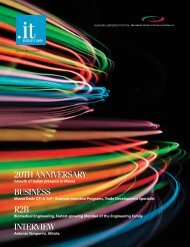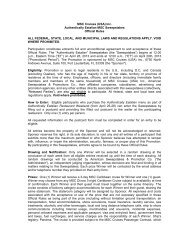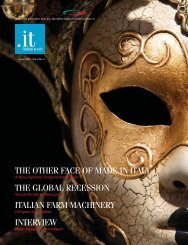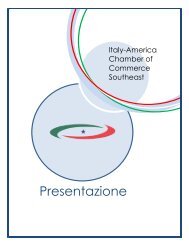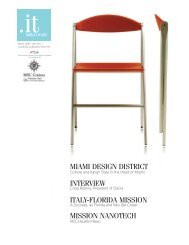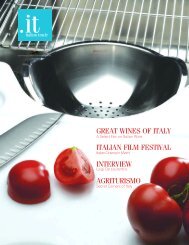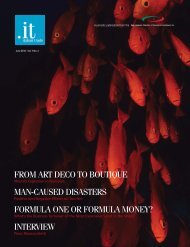interview - Italy-America Chamber of Commerce, Southeast
interview - Italy-America Chamber of Commerce, Southeast
interview - Italy-America Chamber of Commerce, Southeast
You also want an ePaper? Increase the reach of your titles
YUMPU automatically turns print PDFs into web optimized ePapers that Google loves.
DESTINATIONS<br />
Il Palio di Siena<br />
A MEDIEVAL TRADITION STILL ALIVE<br />
BY STAN DOUGLAS, PRESIDENT AND OWNER, PALIO TOURS<br />
In the mind <strong>of</strong> the casual observer, the Palio <strong>of</strong> Siena appears<br />
to be a crazy, but simple horse race. With but 3 laps around<br />
the city’s shell-shaped city center, Piazza del Campo, the race<br />
itself is over in a matter <strong>of</strong> a minute or two. However, for the<br />
Sienesi the thoughts and feelings <strong>of</strong> il Palio are with them<br />
year round, and then on display for all to see during the 4<br />
days <strong>of</strong> the festival, held twice every summer on the 2nd<br />
<strong>of</strong> July and 16th <strong>of</strong> August. In the hearts and minds <strong>of</strong> the<br />
citizens <strong>of</strong> this small Tuscan town, the Palio is the essence <strong>of</strong><br />
their life and over the centuries an event that has molded<br />
not only the character <strong>of</strong> this beautiful medieval city, but the<br />
people as well.<br />
The Palio can be first documented as taking place in Siena<br />
as early as 1238, with the expectation that such horse races<br />
were being contested even prior. The word ‘Palio’ is derived<br />
from the Latin, “pallium” which describes a cloth, or banner<br />
<strong>of</strong> fine material such as silk and typically adorned with other<br />
artistic enhancement. In the early races (as now) this banner<br />
was awarded to the winner and thus the name associated<br />
with the banner also became attached to the race itself.<br />
The current format <strong>of</strong> the festival and the race has been<br />
more or less the same since the early 18th century. Horses<br />
are selected at a random draw (tratta) 3 days prior to the race<br />
to represent each <strong>of</strong> the Contrada (city districts) <strong>of</strong> Siena.<br />
While only 10 <strong>of</strong> the total 17 Contrada are represented in<br />
the race itself, deep historical alliances and long standing<br />
adversarial relationships take over among the Contrada.<br />
The leaders <strong>of</strong> each Contrada assign their selected jockey<br />
a “race strategy” which in many instances can only be<br />
confirmed once the sequence <strong>of</strong> the horses for the starting<br />
gate is revealed. This sequence is only determined minutes<br />
before the race is to begin and is delivered by the starter<br />
(mossiere) as he announces the name <strong>of</strong> each Contrada to<br />
the thousands <strong>of</strong> people in the campo. This assigns each<br />
horse and jockey their starting positions and the possible<br />
fate <strong>of</strong> the Contrada. With the random horse selections and<br />
the last minute knowledge <strong>of</strong> the starting sequence, the city<br />
and its Contradioli (Contrada members) are thus consumed<br />
with anxious thoughts as the drama plays out in the days<br />
leading up to the race and with its eventual outcome. For<br />
the Sienesi, if the “enemy” Contrada wins the race, it will<br />
provide more emotional pain than if their own horse should<br />
simply finish last.<br />
I personally attended the Palio in Siena for the first time<br />
in 1998 and found it to be like no other event I had ever<br />
witnessed. Yes, the “anything goes” style <strong>of</strong> the race was<br />
exciting and the medieval setting <strong>of</strong> Siena and Piazza del<br />
Campo is like stepping back in time to the middle ages, but<br />
the finality <strong>of</strong> the race, the emotional state <strong>of</strong> both joy and<br />
sadness that consumes all the Sienesi was for me – il Palio<br />
– and the reason I wanted to find a way to return, not just<br />
once, but every year.<br />
.39




